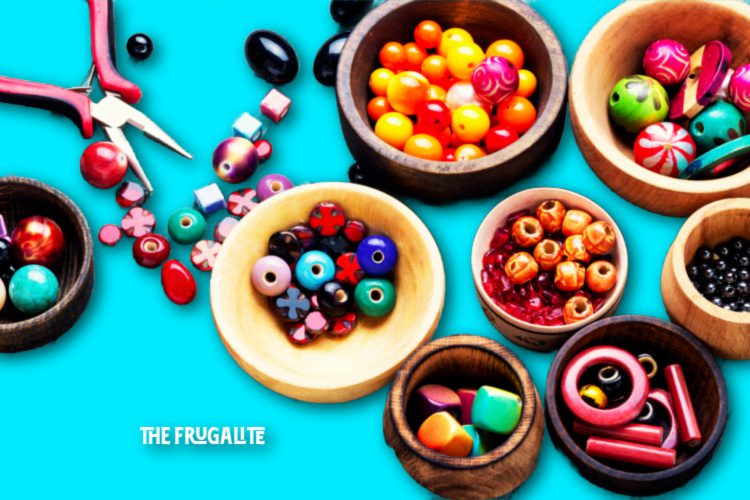(Psst: The FTC wants me to remind you that this website contains affiliate links. That means if you make a purchase from a link you click on, I might receive a small commission. This does not increase the price you’ll pay for that item nor does it decrease the awesomeness of the item. ~ Daisy)
These days, most people like to support local when possible rather than big box stores. After all, when you support local, you are putting your money right back into your community, and you’re often getting something of much better quality. If you’re someone who makes something, it can seem like a daunting task to break into the market, but it doesn’t have to be. Here are some ways you can sell your handmade products.
Finding a place to sell your handmade goods
This can seem like a daunting task, but it’s often easier than you might imagine. Many small or boutique stores these days help support and sell things made by local artists. I personally just got some things into two small run businesses in the little town next door. While I was nervous to approach the owners at first, they were both amazing and sweet and helped walk me through the process.
Here’s what you need to do after you’ve found a store that may be a potential fit:
- Have a portfolio with images of your work or a few small pieces on hand.
- Look presentable and be polite; it can go a long way.
- Ask to speak to the owner and if they accept work from local artists.
- Be prepared to take feedback or that some items may not be a good fit for a specific place. That doesn’t mean it can’t go elsewhere, though.
What can you sell?
Some stores will have a theme, others, not so much. For the most part, though, there is a large variety of things that can be sold in any given shop. If you have a talent or hobby for making things, it never hurts to try. After all, it could generate at least a little income for something you already enjoy doing or, at the very least, cover the expenses of your hobby (some are more expensive than others.)
Here are some possible things that can be sold in local stores:
- Paintings
- Sculptures
- Pottery
- Wood carvings
- Handmade jewellery
- Leatherwork
- Crocheted or knitted items
- Handmade clothing
- Dolls
- Decor
What to expect
There are a few things that you’ll need to know ahead of time to make sure it is a good fit.
Getting Profits
While in most cases, you will end up with most of the profit, it’s important to remember that the owner of the store needs to make money, too, so in one way or another, there will be a bit of a charge. Here are the typical ways most store owners work with local creators:
- Splitting Profits: Some stores will split profits with you. The first store I got into does an 80/20 split, so if I’m selling something for $10, I get $8, and the store gets $2. This is probably one of the better options, especially if you are just starting out.
- Paying for a shelf: Some stores will have you pay a certain amount for a shelf space, and you can put as much or as little as you want there. When you pay for a shelf, it usually means you get 100% of the money for items sold; however, it also means that you’re going to have some upfront expenses.
- Buying products outright: While a little rare, some stores will purchase everything from you upfront at a set rate. This is great because your money is no longer dependent on the item being sold.
Most local shops that opt for splitting profits or paying for a shelf will have a set pay schedule, whether it’s weekly, bi-weekly, or monthly.
Be Prepared for Feedback
Be open to feedback. The shop owners are the experts in their shops. They often know what will sell and what won’t. Be open to some potential tweaks they may have for your handmade items, or the fact that some just may not work in a given store. You may try out some items, and they may wind up coming back in a month because they weren’t as popular as expected. That doesn’t mean they’re not great items, it just means you haven’t found the right audience or buyers.
Know how to price your items.
Do a little market research or googling ahead of time. See if you can find something similar to the item you selling online or on places like Etsy. See what it’s going for, calculate how many hours and the cost of supplies you put into something. Don’t devalue the worth of the item you’ve created by selling it dirt cheap. If you’re not sure about a price point, ask the store owner for their thoughts; after all, you’re both hoping to make a profit, and they’ll also have a good idea of what their clientele will spend on certain items.
Don’t let imposter syndrome stop you.
I don’t know about you, but most creative people I know, myself included, struggle with imposter syndrome. That feeling that the things we do or make aren’t quite good enough. That no one would actually want to spend money on it. This is an age-old struggle, but I challenge you to face it. Even if you don’t think you’re ready, take a leap and try. Go in, talk to the store owners, and see what they say. They very well might tell you that certain items would need to be improved a bit, but they may also have suggestions as to how you can actually accomplish that.
If they do give you feedback and tell you to come back after some adjustments, try! It never hurts, and you never know what amazing things could result.
Have you ever sold work as a local artist?
While it can be daunting, it can also be exhilarating. Not only will getting into local shops help you to generate more income, but it can also help to pay for the expenses of your hobby, grow your confidence in your own abilities, and maybe even lead you down a path for income that you didn’t think was actually possible. After all, it never hurts to try to sell.
Have you ever sold things you’ve made in local shops? Do you have any tips or tricks for those just starting out? Have you sold things in local shops that I haven’t listed? What are some things you look for when buying local? And what do you make? Let’s discuss this in the comments!
About Chloe Morgan
Chloe Morgan grew up living with a tight budget. In her late teens and early 20’s, all the lessons she’d learned started to slip, like it does for many college-age students on their own for the first time with their first credit card. As she’s gotten older, she’s started to deal with the repercussions and has taken on a frugal way of living, keeping her costs low, as she pays off debt and saves for her future. Chloe lives in Northern Ontario, Canada, with her dog, Rhea.
Check out her work on TheOrganicPrepper.com and TheFrugalite.com where she writes about food, frugality, finances, and self-reliance, or her work on Medium, where she writes about lifestyle, mental health, and writing.











2 thoughts on “How to Make Money Selling Handmade Goods”
I liked your article. Good advice. I sell handmade greeting cards. I don’t sell online but have my cards in two local stores. One is with a friend who has a small shop selling beef, pork, eggs, honey, etc. Some of my cards there are seasonal but many are fun cow and bee cards. I heard about a tea room nearby and went with a friend for lunch. My friend loves tea so I gave her a decorated bag of “tea” inspired cards. She showed to the tea shop owner and now my cards are in her shop by the cash register. I had my cards in a local floral shop but it ended up closing.
It can be intimidating to approach shop owners with my cards but I force myself to take that step. For me, it has been worth it. I don’t make a huge amount of money but it helps support my hobby. I call it my fun money. I like to encourage others by sending cards or give them as gifts so it’s not always about making money.
Great advice! I make leather handgun holsters and knife sheaths. I sell locally and through a few online forums. I’ve yet to have a bad experience.